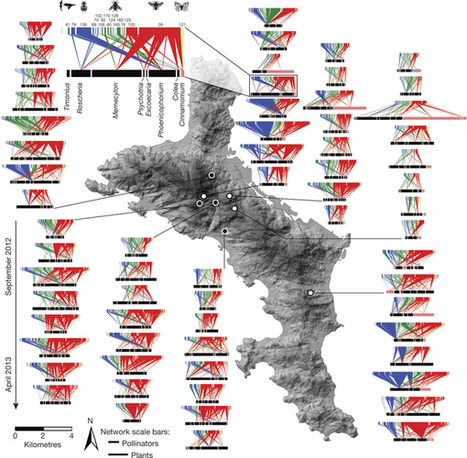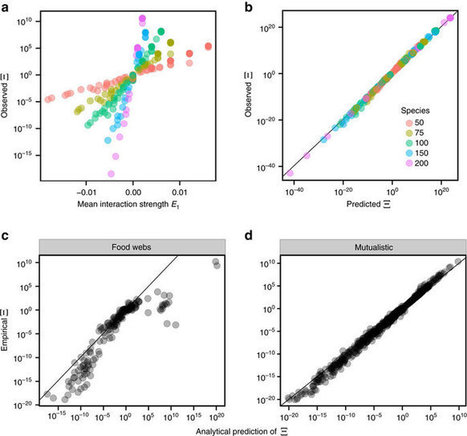 Your new post is loading...
 Your new post is loading...
Empirical evidences show that ecosystems with high biodiversity can persist in time even in the presence of few types of resources and are more stable than low biodiverse communities. This evidence is contrasted by the conventional mathematical modeling, which predicts that the presence of many species and/or cooperative interactions are detrimental for ecological stability and persistence. Here we propose a modelling framework for population dynamics, which also include indirect cooperative interactions mediated by other species (e.g. habitat modification). We show that in the large system size limit, any number of species can coexist and stability increases as the number of species grows, if mediated cooperation is present, even in presence of exploitative or harmful interactions (e.g. antibiotics). Our theoretical approach thus shows that appropriate models of mediated cooperation naturally lead to a solution of the long-standing question about complexity-stability paradox and on how highly biodiverse communities can coexist.
Via Samir
Complex systems such as cells, brains, or ecosystems are made up of many interconnected elements, each one acting on its neighbors, and sometimes influencing its own state via feedback loops. Certain biological networks have surprisingly few such loops. Although this may be advantageous in various ways, it is not known how feedback is suppressed. We show that trophic coherence, a structural property of ecosystems, is key to the extent of feedback in these as well as in many other systems, including networks related to genes, neurons, metabolites, words, computers, and trading nations. We derive mathematical expressions that provide a benchmark against which to examine empirical data, and conclude that “looplessness” in nature is probably a consequence of trophic coherenc
Land degradation results in declining biodiversity and the disruption of ecosystem functioning worldwide, particularly in the tropics1. Vegetation restoration is a common tool used to mitigate these impacts and increasingly aims to restore ecosystem functions rather than species diversity2. However, evidence from community experiments on the effect of restoration practices on ecosystem functions is scarce3. Pollination is an important ecosystem function and the global decline in pollinators attenuates the resistance of natural areas and agro-environments to disturbances4. Thus, the ability of pollination functions to resist or recover from disturbance (that is, the functional resilience)5, 6 may be critical for ensuring a successful restoration process7. Here we report the use of a community field experiment to investigate the effects of vegetation restoration, specifically the removal of exotic shrubs, on pollination. We analyse 64 plant–pollinator networks and the reproductive performance of the ten most abundant plant species across four restored and four unrestored, disturbed mountaintop communities. Ecosystem restoration resulted in a marked increase in pollinator species, visits to flowers and interaction diversity. Interactions in restored networks were more generalized than in unrestored networks, indicating a higher functional redundancy in restored communities. Shifts in interaction patterns had direct and positive effects on pollination, especially on the relative and total fruit production of native plants. Pollinator limitation was prevalent at unrestored sites only, where the proportion of flowers producing fruit increased with pollinator visitation, approaching the higher levels seen in restored plant communities. Our results show that vegetation restoration can improve pollination, suggesting that the degradation of ecosystem functions is at least partially reversible. The degree of recovery may depend on the state of degradation before restoration intervention and the proximity to pollinator source populations in the surrounding landscape5, 8. We demonstrate that network structure is a suitable indicator for pollination quality, highlighting the usefulness of interaction networks in environmental management6, 9.
Studies of ecological networks (the web of interactions between species in a community) demonstrate an intricate link between a community’s structure and its long-term viability. It remains unclear, however, how much a community’s persistence depends on the identities of the species present, or how much the role played by each species varies as a function of the community in which it is found. We measured species’ roles by studying how species are embedded within the overall network and the subsequent dynamic implications. Using data from 32 empirical food webs, we find that species’ roles and dynamic importance are inherent species attributes and can be extrapolated across communities on the basis of taxonomic classification alone. Our results illustrate the variability of roles across species and communities and the relative importance of distinct species groups when attempting to conserve ecological communities.
|
The networks that form natural, social, and technological systems are vulnerable to the spreading impacts of perturbations. Theory predicts that networks with a clustered or modular structure—where nodes within a module interact more frequently than they do with nodes in other modules—might contain a perturbation, preventing it from spreading to the entire network. Gilarranz et al. conducted experiments with networked populations of springtail ( Folsomia candida ) microarthropods to show that modularity limits the impact of a local extinction on neighboring nodes (see the Perspective by Sales-Pardo). In networks with high modularity, the perturbation was contained within the targeted module, and its impact did not spread to nodes beyond it. However, simulations revealed that modularity is beneficial to the network only when perturbations are present; otherwise, it hinders population growth.
Science , this issue p. [199][1]; see also p. [128][2]
[1]: /lookup/doi/10.1126/science.aal4122
[2]: /lookup/doi/10.1126/science.aan8075
The role of species interactions in controlling the interplay between the stability of ecosystems and their biodiversity is still not well understood. The ability of ecological communities to recover after small perturbations of the species abundances (local asymptotic stability) has been well studied, whereas the likelihood of a community to persist when the conditions change (structural stability) has received much less attention. Our goal is to understand the effects of diversity, interaction strengths and ecological network structure on the volume of parameter space leading to feasible equilibria. We develop a geometrical framework to study the range of conditions necessary for feasible coexistence. We show that feasibility is determined by few quantities describing the interactions, yielding a nontrivial complexity–feasibility relationship. Analysing more than 100 empirical networks, we show that the range of coexistence conditions in mutualistic systems can be analytically predicted. Finally, we characterize the geometric shape of the feasibility domain, thereby identifying the direction of perturbations that are more likely to cause extinctions.
The occurrence of complex networks of interactions among species not only relies on species co-occurrence, but also on inherited traits and evolutionary events imprinted in species phylogenies. The phylogenetic signal found in ecological networks suggests that evolution plays an important role in determining community assembly and hence could inform about the underpinning mechanisms.
|



 Your new post is loading...
Your new post is loading...










